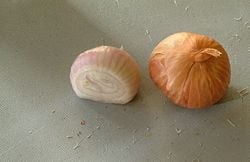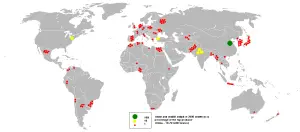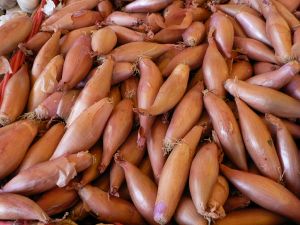Shallot
| Shallot | ||||||||||||||
|---|---|---|---|---|---|---|---|---|---|---|---|---|---|---|
 Shallots
| ||||||||||||||
| Scientific classification | ||||||||||||||
| ||||||||||||||
| Allium oschaninii O. Fedtsch |
- For other uses, see Shallot (disambiguation).
Shallot is the common name for an edible, bulbous, herbaceous plant, which is related to the onion (Allium cepa), but has a cluster of small bulbs rather than a single large bulb, each covered by a thin, papery skin. Plants known as shallots are variously classified as a variety of onion, Allium cepa var. aggregatum (GRIN 2008a; PFAF 2008a), or as a separate species, A. ascalonicum (Herbst 2001; PFAF 2008a), with such apparent synonyms used as A. cepa ascalonicum (PFAF 2008a), A. cepa aggregatum Group (GRIN 2008a; Bender and Bender 2005), and A. escalonium (Bender and Bender 2005). Other common name include multipler onion (GRIN 2008a), and potato onion (PFAF 2008b; GRIN 2008a).
However, the term shallot also is used for other plants. The French grey shallot or griselle, which has been considered to be the "true shallot" by some, is Allium oschaninii, a species that grows wild from Central to Southwest Asia. Furthermore, in some countries spring or green onions (A. cepa) are called shallots, and shallots are referred to by alternative names such as eschallot or eschalotte
Description
The shallot is a relative of the onion, and tastes a bit like an onion but has a sweeter, milder flavor. They are more expensive than onions and can be stored for at least 6 months.[1]
Unlike onions where each plant normally forms a single bulb, shallots form clusters of offsets, rather in the manner of garlic.
Shallots are extensively cultivated and much used in cookery, in addition to being pickled. Finely sliced deep-fried shallots are used as a condiment in Asian cuisine. Shallots tend to be considerably more expensive than onions, especially in the United States.

Shallots are propagated by offsets, which, in the Northern Hemisphere are often planted in September or October, but the principal crop should not be planted earlier than February or the beginning of March. In planting, the tops of the bulbs should be kept a little above ground, and it is a commendable plan to draw away the soil surrounding the bulbs when their roots have taken hold. They should not be planted on ground recently manured. They come to maturity about July or August, although they can now be found year-round in supermarkets.
Similar to onions, raw shallots release chemicals that irritate the eye when sliced, resulting in tears. See onion for a discussion of this phenomenon.
Shallots are particularly high in anti-cancer compounds. [2]
In Australia, the foodstuff industry has renamed a number of vegetables. The name shallot has been applied to scallions, normally called spring onions in Australia, and shallots have been renamed eschalotte. The term French shallot has also been used for Allium oschaninii.
There is a very specific region of shallot gardening in southeastern Ghana.
The name of the shallot derives from the name of the city of Ashkelon (Latin ‘Ascalon’) in ancient Canaan, in Italian its name is "scalogno".
Shallots in Persian Cooking
The shallot in Persian is called موسیر (Moo-Seer), which is often crushed into yogurt. Iranians enjoy yogurt in this way, especially in restaurants and Kebbab-Saras where just kebabs are served. Most shallots are grown wild, harvested, sliced, dried, and sold at markets. Buyers will often soak the shallots for a number of days then boil them to get a milder flavor.
Shallots in South East Asian Cooking
Shallots are called 'bawang merah kecil' (small red onions) in Bahasa Melayu, an official language of Indonesia, Malaysia, Brunei, and Singapore, and "hom" (หอม - literally "fragrant") in Thai. In South East Asian cuisines, such as Thai, Malaysian and Indonesian cuisines, both shallots and garlic ('bawang putih', white onions) are very often used as elementary spices. Raw shallot can also accompany cucumbers when pickled in mild vinegar solution. It is also often chopped finely, then fried until golden brown, resulting in tiny crispy shallot chips called 'bawang goreng' (fried onions)in Indonesian language, which can be bought ready-made from groceries and supermarkets. It enhances the flavor of many South East Asian dishes, such as fried rice variants. In Indonesia, sometimes it is made into pickle which is usually added in variable kinds of traditional food. Its sourness increases one's appetite.
It is widely used in the southern part of India. It is called Sambar Vengayam in Tamil and Kochulli in Malayalam and is used in Sambar (a type of curry) and different types of kuzhambu(curry).
External links
Credits
New World Encyclopedia writers and editors rewrote and completed the Wikipedia article in accordance with New World Encyclopedia standards. This article abides by terms of the Creative Commons CC-by-sa 3.0 License (CC-by-sa), which may be used and disseminated with proper attribution. Credit is due under the terms of this license that can reference both the New World Encyclopedia contributors and the selfless volunteer contributors of the Wikimedia Foundation. To cite this article click here for a list of acceptable citing formats.The history of earlier contributions by wikipedians is accessible to researchers here:
The history of this article since it was imported to New World Encyclopedia:
Note: Some restrictions may apply to use of individual images which are separately licensed.

